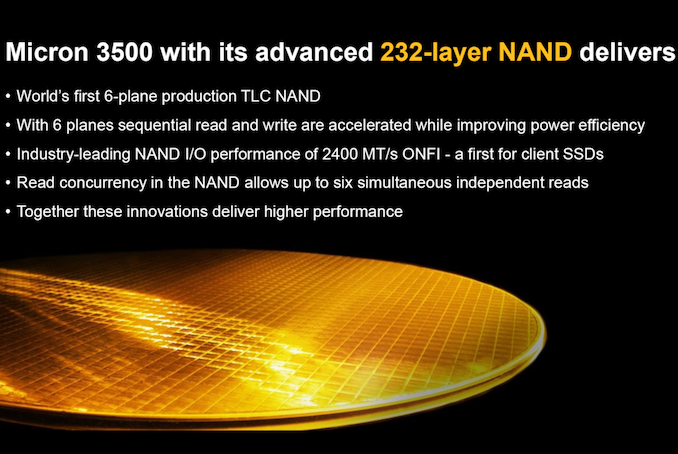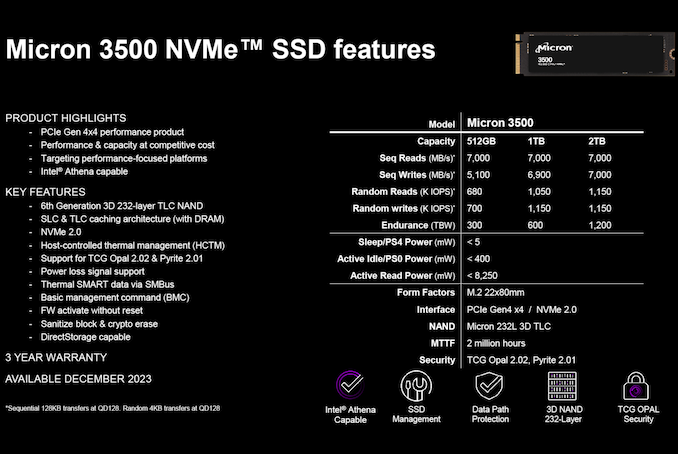Micron Intros 3500 NVMe SSD: 232L 3D TLC and Phison E25 for the OEM Market
by Ganesh T S on December 5, 2023 9:00 AM EST
Micron has been on a roll lately with new product introductions despite the downturn in the flash market. The company is currently the only NAND manufacturer shipping products based on 200+L 3D TLC in volume. Thanks to the advantage of higher bit density and rapid maturity in yields, Micron has better leeway in pricing and margins compared to its peers. As a result, we have had multiple 232L product launches in the enterprise (Micron 6500 ION), OEM (Micron 2550), and consumer (Crucial T700, Crucial T500) segments over the last year. In addition to higher bit density, the 232L 3D TLC NAND also delivers significant bandwidth improvements with its 6-plane architecture.
Micron is launching the 3500 NVMe SSD series today. It is the first PCIe Gen4 x4 232L 3D TLC NAND OEM drive in the market. Micron develops SSD platforms for client systems and markets them under the Crucial brand name for direct purchase by end-users. The company has also been releasing the same platforms under the Micron brand for OEMs and system integrators. Obviously, the validation cycles and OEM qualification requirements dictate a slightly different approach to the firmware compared to what is put into the Crucial drives. As a result, the advertised specifications may differ slightly for the same hardware platform based on the target market. The 3500 NVMe SSD utilizes the same hardware as the recently-released Crucial T500 - Micron's 232L 3D TLC NAND behind the Phison E25 controller operating in 4-channel mode, with the NAND configured for 2400 MT/s and dedicated DRAM on the drive for the flash translation layer (FTL).
Almost all of the key selling points of the Crucial T500 transfer themselves to the Micron 3500 NVMe SSD. These include class-leading bandwidth numbers saturating the Gen4 links and DirectStorage support. The peak reads are at 7 GBps instead of 7.4 GBps, but that is due to the nature of the systems dictated by OEM qualification requirements. Endurance numbers are the same as the T500's, but the warranty period is only 3 years (compared to the T500's 5 years). This actually translates to a higher DWPD rating for the drive, and is a typical demand of the OEMs who qualify these drives for use in their systems. The SSD's power consumption numbers and wake times from sleep are also geared for Intel's Project Athena certification - an aspect that is important for OEMs delivering high-performance notebooks. The target market for the 3500 NVMe SSD is high-end workstations and gaming systems. As a result, Micron's marketing numbers have focused on benchmarks such as SPECwpc storage (part of the SPECworkstation suite). We are looking forward to confirming the claims with our own hands-on evaluation in the near future.
The launch of the Micron 3500 NVMe SSD has enabled the company to cater to the entire range of OEM client systems requiring Gen4 NVMe drives. The entry-level Micron 2400 series with 176L QLC NAND is meant for the cost-sensitive market, while the Micron 2550 moves to 232L 3D TLC with the previous-generation Phison controller. Both drive families are available in multiple M.2 form-factors. The 3500 NVMe SSD fills up the flagship role. With high-end computing systems being the target, the drive will be available only in the M.2 2280 form-factor. It is surprising that a 4TB drive is not available at launch, given that high-end systems are typically hungry for storage capacity. Hopefully, that is a hole in the product stack that Micron will be able to fill in both the Crucial T700 and Micron 3500 NVMe SSD families sometime next year.













7 Comments
View All Comments
Terry_Craig - Tuesday, December 5, 2023 - link
Nothing impressive.sjkpublic@gmail.com - Tuesday, December 5, 2023 - link
The TBW is ok at 600 x size. It is gen4. And the speed is good. What would be impressive is the pricings.mode_13h - Wednesday, December 6, 2023 - link
I just checked out a review of the T500, over on Storage Review, and all I can say is: oof.Let's hope the T500 had some kinks that Micron was able to sort out in firmware, otherwise this one looks to me a lot more like a QLC drive than TLC-based . Read performance is good, but not quite matching either Solidigm's or Samsung's flagships. However, its write performance is abysmal.
Adramtech - Wednesday, December 6, 2023 - link
Yet TweakTown says it's the best PCIe Gen4 SSD ever tested, and website reviews on it are all stellar. https://www.tweaktown.com/reviews/10577/crucial-t5...mode_13h - Thursday, December 7, 2023 - link
Wow, thanks for the link.> TweakTown says it's the best PCIe Gen4 SSD ever tested
So weird, given it came dead last in their PS5 read chart of like 50 different SSDs. It *barely* squeaked over the PS5's minimum threshold of 5500 MB/s. The PS5 only has PCIe 4.0, so being a PCIe 4.0 drive is no excuse for that.
Also, they only tested random writes at 1M. As for 4k random reads, they only tested at Q1T1, which is probably the most relevant metric but doesn't tell the whole story. And even then, it got solidly beat by Samsung 990 Pro - another PCIe 4.0 drive.
Anvil Read Score was another test where it was well-surpassed by some other PCIe 4.0 drives, like the 990 Pro. The Max Read IOPS test had the 990 Pro beating it by a margin of 50%!
Atto's 128k seq. read test had Solidigm's P44 Pro beating it by a good margin.
PCMark's tests also preferred Samsung 990 Pro.
Also, they do this weird thing where they test it on both Intel and AMD, seeming to credit it with the higher of the two scores. However, the scores of the other drives they're comparing against are just from the Intel test system, even when the other drives also scored higher on AMD.
All in all, it's just bizarre for them to heap such praise upon it. It performs between "okay" and "good", in their tests. In a couple, it indeed seems like the fast PCIe 4.0 drive. There's just no way it's "the best PCIe Gen4 SSD ever tested". Not according to their own data. IMO, they made a mockery of themselves with such a statement. It's also strange there are zero comments on that review.
mode_13h - Thursday, December 7, 2023 - link
Toms gave it a slightly more mixed (but still positive) review, rating it at 4/5 stars.https://www.tomshardware.com/reviews/crucial-2tb-t...
As with Storage Review, they found writes to be a problem area, summarizing it as: "Inconsistent sustained write performance". To be specific, the issue seems to be that once its SLC buffer fills up, its write performance drops from being among the best PCIe 4.0 drives to among the worst. Perhaps this is also what Storage Review found. They might just have a better preconditioning regime and thus encountered that sooner.
SanX - Wednesday, December 6, 2023 - link
AT turns into second hand market news